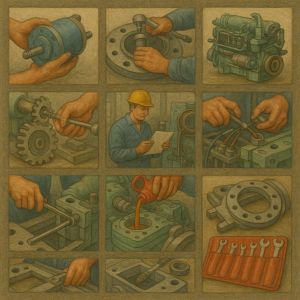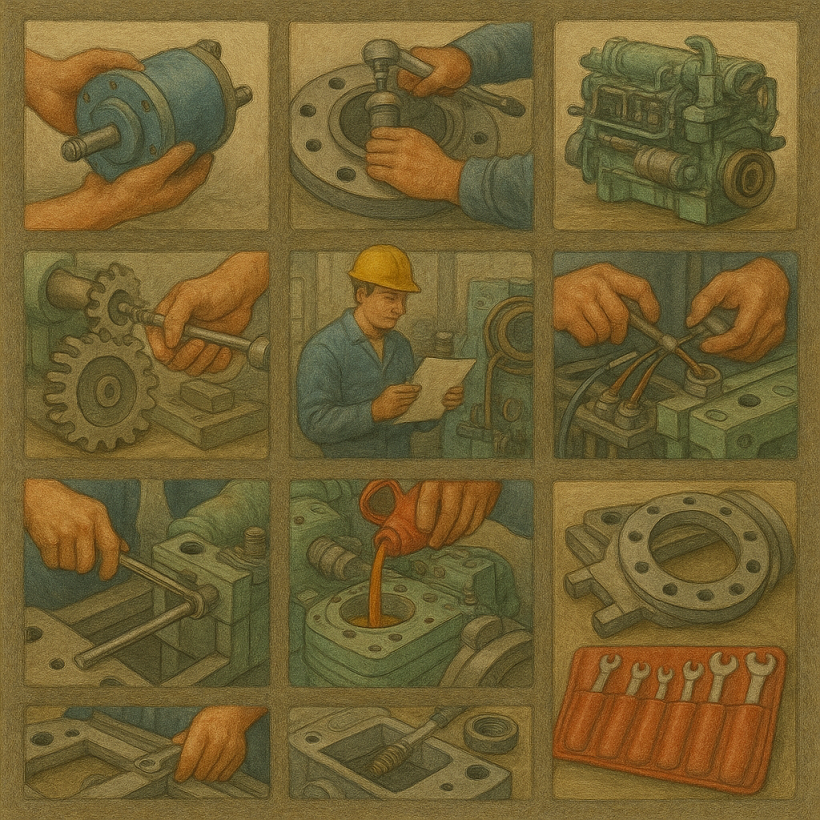Discover the top 12 critical considerations when reassembling ship machinery after maintenance. Learn expert insights, safety checks, and real-world examples to help maritime engineers ensure reliability and compliance.

Why Reassembly After Maintenance Matters in Modern Maritime Operations
In the life of a ship, maintenance isn’t just an occasional task—it’s a routine necessity. Whether it’s part of a scheduled overhaul, class survey, or an unexpected breakdown, disassembling and reassembling machinery is part of a marine engineer’s day-to-day reality. But what happens after the repair is just as critical as the repair itself.
Reassembly is where things can go very right—or dangerously wrong. Incorrect torque, poor alignment, forgotten locking wires, or contamination during closure can lead to catastrophic failures. As per the Marine Accident Investigation Branch (MAIB), machinery malfunction is cited as a root cause in over 25% of reported shipboard incidents. ABS and DNV also highlight reassembly errors among top contributors to machinery-related port detentions.
Let’s dive into the top 12 things you should always consider while reassembling ship machinery after maintenance.
1. Cleanliness: Your First Line of Defence
Cleanliness may sound basic, but it’s absolutely foundational. Reassembling a turbocharger or a fuel injection pump with even tiny metal particles, old gasket bits, or moisture can reduce efficiency—or worse, cause internal scoring and failure.
Engine rooms are often humid and dusty environments. Always use lint-free cloths, compressed air, and approved cleaning solvents (as specified by OEMs like MAN Energy Solutions or Wärtsilä). Keep parts covered when not in use.
2. Correct Use of Tools and Torque Settings
Modern ship engines are precision-built. Using a standard wrench instead of a torque wrench, or over-tightening bolts based on “feel,” can cause cracks, misalignment, or gasket failure.
Manufacturers such as Sulzer and Hyundai Heavy Industries provide exact torque specifications for every major component. Always refer to the engine maker’s manual, and double-check with classification society-approved checklists (e.g., ClassNK or Lloyd’s Register).
3. Gasket and Seal Replacement
Reusing old gaskets or O-rings might save a few minutes—but it could cost a ship a few hours or days in unplanned downtime.
Always replace gaskets, washers, and O-rings with manufacturer-approved spares. Watch for directionality and seated position. In systems like cylinder head covers or jacket water pumps, this step is essential to avoid coolant leaks or oil blow-by.
4. Proper Alignment and Clearance Checks
Improper alignment during reassembly can result in increased vibration, abnormal wear, or shaft failure. This is especially critical for:
- Main engine bearings
- Pump impellers
- Gearbox shafts
Use dial gauges, feeler gauges, or laser alignment tools where required. The IACS recommends verifying axial and radial runouts before final tightening, especially in propulsion shafting systems.
5. Locking Devices and Safety Pins
A missing locking wire, split pin, or tab washer might go unnoticed at first—but it could cause component loosening during operation, with disastrous effects.
Double-check:
- Cotter pins on crankpin bolts
- Locking wires on indicator cocks or cylinder head covers
- Safety keys on rotating shafts
Classification societies like RINA and BV require visual confirmation and documentation of these during shipboard audits.
6. Lubrication: Timing and Technique
Lubricating before and during assembly is not a one-size-fits-all task. Some components need a light oil film (e.g., piston pins), while others may require heavy grease (e.g., stern tube seals).
Never over-lubricate components like crankshaft journals or turbocharger bearings—it can create backpressure and affect oil flow.
7. System Pressure Testing and Leak Checks
Before re-commissioning a pump, cooler, or fuel line, perform a proper hydrostatic or pneumatic pressure test. Pressure testing ensures the integrity of gaskets and seals installed during reassembly.
The IMO STCW Code requires engine officers to confirm “watertight integrity and system tightness” before full operation. A leak during sea trials can quickly become an emergency.
8. Ventilation and Purging Before Start-up
Residual gases, airlocks, or cleaning agents can remain inside freshly serviced equipment. It’s critical to:
- Vent jacket water circuits
- Bleed fuel lines
- Purge air from lubricating oil systems
As per the Wärtsilä operation manual, failure to do so can cause cavitation, poor atomization, or hydraulic shock.
9. Sensor Reconnection and Calibration
In the age of digital twins and predictive maintenance, every sensor matters. During reassembly, confirm that all:
- Thermocouples
- Pressure transmitters
- Flow meters
- RPM sensors
…are reconnected, intact, and calibrated. Incorrect sensor data can lead to false alarms or delayed shutdowns—some of which can endanger crew safety.
10. Follow-Up Inspection and Double Verification
No matter how confident you are, a second check never hurts. Ideally, another officer should verify the critical stages:
- Torque values
- Coupling alignments
- Locking arrangements
The ISM Code (International Safety Management) emphasizes cross-checking by duty engineers as part of its safety management procedures.
11. Updating Maintenance Logs and Technical Records
Every reassembly should be followed by documentation. This includes:
- What was done
- Who did it
- What parts were changed
- Any deviations from normal procedures
As per IMO Model Course 7.04 (for Engine Officers), these records must be accurate and available for vetting, PSC inspections, and class audits. Digital systems like Amos or NS5 can assist in structured documentation.
12. Gradual Start-Up and Monitoring Post-Reassembly
Once reassembly is complete, do not jump straight to full RPM or load. Start gradually. Monitor:
- Bearing temperatures
- Lubricating oil pressures
- Vibration levels
- Unusual noises or odors
It’s wise to run the system at idle or test load for at least 15–30 minutes. The first few minutes post-reassembly are often the most revealing.
Real-World Example: Crankcase Explosion Due to Assembly Error
In 2021, a vessel in the Mediterranean experienced a crankcase explosion shortly after departure. Investigation by EMSA revealed that a main engine connecting rod was torqued incorrectly during reassembly, causing a bolt to shear. This led to oil mist formation and subsequent ignition.
The vessel had to be towed to port, and the engine was declared a total loss. The lesson? A missed torque setting became a million-euro mistake.
Frequently Asked Questions (FAQ)
Why is it important to follow torque values during reassembly? Because uneven or excessive torque can damage threads, cause distortion, or lead to uneven stress distribution.
What tools are essential for proper reassembly? Torque wrenches, dial indicators, alignment kits, borescopes, and OEM service manuals.
Should we replace gaskets even if they appear fine? Yes. Gaskets and O-rings lose elasticity over time and may not reseal properly after reuse.
What are the most common mistakes during machinery reassembly? Missing locking devices, improper lubrication, incorrect sensor reinstallation, and poor documentation.
How long should machinery be tested after reassembly? At least 15–30 minutes at low load or idle. Monitor parameters and perform leak checks.
Conclusion: Precision Is Power in Marine Engineering
Reassembling ship machinery is a skillful balance between speed and precision. Every nut, gasket, and sensor matters. Whether it’s a turbocharger overhaul, fuel pump replacement, or bearing inspection, these 12 considerations act as your checklist to safety, performance, and compliance.
In today’s high-stakes maritime world, engineers must treat reassembly not as the final step—but as the point where reliability is truly re-established. Done well, it extends equipment life. Done poorly, it jeopardizes lives and careers.
Let this guide serve as a practical compass for every engine room team striving for excellence.
References
- International Maritime Organization – STCW Code
- Marine Accident Investigation Branch (MAIB)
- Wärtsilä Technical Manuals
- MAN Energy Solutions Maintenance Procedures
- DNV Guidelines on Machinery Maintenance
- IACS Unified Requirements
- ABS Rules for Survey After Construction
- ClassNK Technical Information
- The Nautical Institute – Engineering Best Practices
- IMO Model Course 7.04
- RINA Technical Rules
- Bureau Veritas – Machinery Surveys

